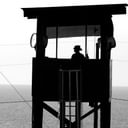Adam Ashton
The News Tribune
June 18, 2012
Two soldiers are awaiting courts-martial at Joint Base Lewis-McChord on multiple charges of murder that could send them to the Army’s death row. But recent history suggests a military jury would be reluctant to use that punishment on defendants whose alleged crimes were committed in a combat zone.
Of the 2, the soldier accused of turning a weapon on fellow servicemembers in Iraq is more likely to face the death penalty than the Stryker infantryman who allegedly slaughtered Afghan civilians unprovoked – at least based on the military’s record in court.
Sgt. John Russell faces trial in the killing of five U.S. servicemembers at a mental health clinic in Iraq’s Camp Liberty 3 years ago. The death penalty is on the table, even though a judge recommended the Army withdraw that punishment because of Russell’s well-documented, deteriorating psychological condition during his third deployment to Iraq.
The other soldier with a potential capital case at Lewis-McChord is Staff Sgt. Robert Bales, formerly of Lake Tapps, who allegedly murdered 16 Afghan civilians the night of March 11. He’d been stationed at the base for a decade and was on his fourth combat tour.
The Army has not yet said whether Bales will face the death penalty when his case proceeds to a court-martial. His attorney, John Henry Browne of Seattle, is reviewing the Army’s evidence and preparing to fight the charges.
In either case, history suggests the Army is unlikely to carry out an execution even if it wins convictions.
50 YEARS
Its last execution took place in 1961. McClatchy Newspapers last year reported that 10 of the 16 servicemembers sentenced to death since 1984 had their punishments overturned.
“We don’t fall all over ourselves in general to execute our own people,” said Eugene Fidell, who teaches military justice at Yale University. “It’s been over 50 years now since we’ve executed a U.S. soldier and there have been plenty of death sentences, but juries and the appellate courts and the reviewing authorities including presidents do not have itchy fingers when it comes to the death penalty,” Fidell said.
Today, 6 men are on death row at Fort Leavenworth, Kan.
Their crimes resemble the charges against Russell more so than the Army’s case against Bales: All 6 are there for killing other Americans, not for crimes committed against foreign noncombatants.
However, only 1 of the 6 committed his crimes while deployed overseas.
Soldiers who murder civilians in war zones are more likely to face a life sentence as their most serious punishment.
For instance, the Army did not pursue a death sentence against any of the four Lewis-McChord soldiers who were convicted last year in connection with the murders of three Afghan civilians in 2010. The ringleader of this so-called “kill team,” former Staff Sgt. Calvin Gibbs, received a life sentence with the possibility of parole.
Another convicted war criminal, former Pfc. Steven Dale Green, received a life sentence without parole for raping and killing a 14-year-old Iraqi girl, then leading a group of soldiers in killing her family in 2006.
“History and experience would seem to indicate that (court-martial) convening authorities will more readily send a case to trial as a death-penalty case if the victims are Americans than they would if the victims are civilian noncombatants,” said Gary D. Solis, who teaches military law as an adjunct professor at Georgetown University.
The factors weighing on that decision include the “fog of war” argument: The American public and combat commanders understand that civilians die in every conflict because of accidents and split-second judgment calls. Solis noticed a similar trend during the Vietnam War, when reprehensible crimes against Vietnamese civilians did not result in equally serious punishment. The My Lai massacre is the most famous example. Then-Lt. William Calley, who was convicted of killing 22 civilians, served a 3‑year sentence on house arrest.
Solis, a former Marine officer, wrote a book about the massacre of 16 Vietnamese women and children at the village of Son Thang in 1970 by a 5‑man Marine patrol. The ringleader, former Lance Cpl. Randall Herrod, was acquitted.
Solis said the pattern could change if prosecutors believe they can demonstrate that servicemembers in situations like Bales’ deliberately planned homicides, Solis said.
He said he does not have a sense whether Bales will go to trial facing the death penalty. The Army alleges Bales intentionally murdered the 16 Afghan civilians, including women and children, in 2 villages after he sneaked out of a Special Forces outpost in the southern province of Kandahar.
“Given the nature of the deployments and some of the background information we are discovering, he should not face the death penalty,” said Emma Scanlan, one of Bales’ defense attorneys. “That’s not an appropriate possible punishment for him.”
Lead defense attorney Browne has criticized the Army’s case as deficient in physical evidence. In past interviews, he has suggested that Bales was experiencing post-traumatic stress and possibly the effects of mood-altering steroids.
For now, the 38-year-old husband and father of 2 young children is at Fort Leavenworth awaiting a transfer to Lewis-McChord.
MILITARY VICTIMS
Russell’s case diverges from Bales’ because the victims wore U.S. military uniforms. But advocates for the soldier from Sherman, Texas, insist his circumstances are different than those of the 6 servicemembers on death row.
Russell’s attorney argues that behavioral health specialists in Iraq mistreated Russell when he turned to them for help, once dressing him down and another time making light of his distress.
At the time, Russell was serving with a Germany-based combat engineer unit that was attached to a Lewis-McChord brigade. He was not stationed at Lewis-McChord at any time, and is only being prosecuted here because his chain of command is based here.
Russell’s unit sent him to a clinic on May 8, 2009, following 6 days of mood swings and paranoia. At the clinic, a major chose to make an example of Russell in front of a captain whom she regarded as too soft with patients, according to legal documents.
The captain remembered Russell’s 1st visit to the clinic as “aggressive and hostile” because of the major’s tough questioning, according to court testimony quoted in case documents.
“I know Sgt. Russell felt very uncomfortable, and he kept looking to me for reassurance, but what do you do when a senior officer is there? You don’t do anything; you sit, and you listen,” Capt. Brian Ropson said at a pretrial hearing.
Russell’s follow-up visits to the clinic became even more argumentative. His condition worsened noticeably to the soldiers in his unit on May 10. “He felt that everyone had lost hope in him and no one wanted him around,” remembered Lt. David Vasquez in a sworn statement.
On May 11, Russell stormed out of a meeting with another counselor, Lt. Col. Michael Jones. Russell did not believe Jones was willing to help him.
Russell told Jones he was ready to kill himself, but Jones appeared skeptical to witnesses who overheard their interactions. By then, a lieutenant had already taken the bolt from Russell’s rifle, a step that showed his unit believed Russell would hurt himself with the gun.
Later that day, Russell returned to the clinic and killed a Navy commander and four soldiers. An Army board initially found him incompetent to stand trial. With treatment, Russell is now regarded as able to participate in his defense and capable of standing trial.
Army Judge Col. James Pohl wrote that Russell’s trial should not be a capital case. Rather, Pohl in September wrote that Russell’s “undisputed mental disease or defect makes the death penalty inappropriate in this case.”
Pohl is the same officer who recommended that Maj. Nidal Malik Hasan face the death penalty for killing 13 people at Fort Hood, Texas, in 2009. Still, the Army is prosecuting Russell as a capital case.
Defense attorney James Culp contends a military panel will not sentence Russell to death if the case proceeds to trial.
“Do we kill someone who is suffering from 2 severe mental defects when he snaps and does something in a combat zone? I think the answer is no,” Culp said.
Who’s on military death row
Former Marine Lance Cpl. Kenneth Parker
Year sentenced: 1995
Crime: Murdered 2 fellow lance corporals in Jacksonville, N.C.
Former Army Spc. Ronald Gray
Year sentenced: 1988
Crime: Convicted of abducting, raping and murdering an 18-year-old private; raping and murdering a 23-year-old civilian; raping, robbing and attempting to murder another victim, all in the Fayetteville, N.C., area.
Former Army Pfc. Dwight Loving
Year sentenced: 1989
Crime: Murdered 2 taxicab drivers in Killeen, Texas, while based at Fort Hood.
Former Army Sgt. Hasan Akbar
Year sentenced: 2005
Crime: Killed an Air Force major and Army captain while wounding 14 others by tossing a grenade at them at a U.S. base in Kuwait during the invasion of Iraq.
Former Air Force Senior Airman Andrew Witt
Year sentenced: 2005
Crime: Murdered a senior airman and his wife at Robins Air Force Base in Georgia; also seriously wounded a staff sergeant.
Former Army Master Sgt. Timothy Hennis
Year sentenced: 2010
Crime: Murdered 3 people in North Carolina in 1985. He was convicted in 2010 after 3 trials.
Upcoming capital cases
Army Maj. Nidal Malik Hasan
Charges: Murdering 13 people at Fort Hood, Texas, in 2009.
Army Sgt. John Russell
Charges: Murdering 5 service members at a mental health clinic in Iraq in 2009.



